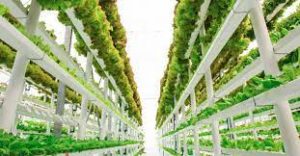What Is Vertical Farming?

India is evolving every day with something new. Also, industrialization is increasing dramatically due to which many arable lands are at greater risk. Vertical farming in India is the answer to all these problems.
- The modern concept was first proposed in 1999 by professor Dickson Despommier. His concept centered on the idea that urban areas should grow their own food which can save time and resources required for transportation.
- Instead of horizontally on the ground like traditional farming, vertical farming grows crops in vertical, stacked layers without putting too much impact on land and water resources which are scarce.
- It includes soilless farming techniques, among others.
- Vertical farming systems like aeroponics and hydroponics come under the broad umbrella ambit of ‘protected cultivation’, where one can control and regulate multiple variables like water, soil, temperature, humidity, and so on.
- Protected cultivation, when practised at scale, offers a massive potential to shorten and optimise our farm-to-plate supply chains by making food available closer to the consumer and thereby can go a long way to improve our nation’s GDP (Gross Domestic Product) and reduce imports dependency.
- Types:
- Hydroponics: Hydroponics is a method of growing plants in a water-based, nutrient-rich solution.
- In this method, the root system is supported using an inert medium such as perlite, clay pellets, peat moss or vermiculite.
- The main purpose is to provide access to oxygen which is essential for proper growth.
- Aeroponics: Aeroponics is an environment-friendly way of farming in which the roots are suspended in the air and plants grow in a humid environment without soil.
- Aquaponics: Aquaponics is a system that combines hydroponics and aquaculture within a closed system.
- There are three biological components in the aquaponics process: fishes, plants, and bacteria.
- Hydroponics: Hydroponics is a method of growing plants in a water-based, nutrient-rich solution.




